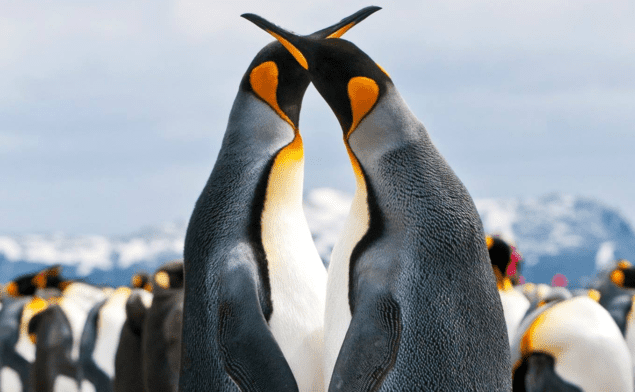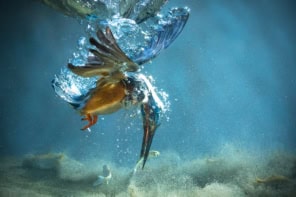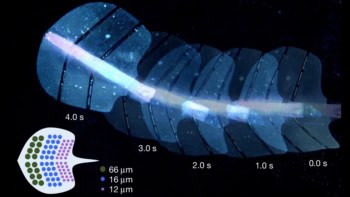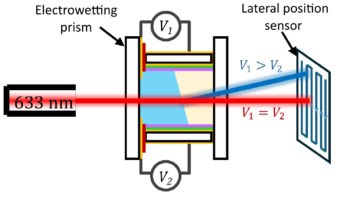
The distribution of sites occupied by breeding pairs of king penguins resembles that of molecules in liquid that has been cooled suddenly to form a glass-like structure. That is the conclusion of an international team of physicists that has analysed penguin colonies using a simple model developed nearly a century ago to explain interactions between atoms and molecules.
The researchers believe that king penguins adopt the glassy structure because it can “heal” itself in the wake of external disturbances such as wayward seals wandering through a colony.
King penguins reproduce on islands in the Southern Ocean, where they come together in the summer to form breeding colonies of as many as one million birds. Unlike some other penguins, however, these birds do not build nests. Instead, a breeding pair will incubate their egg in one location on the ground, which they protect from other penguins. Individual breeding sites are regularly spaced and the overall structure of the colony remains highly stable over the two months it takes for the eggs to incubate.
Aggressive birds
When a female king penguin lays an egg, the parents take turns incubating by carrying the egg on their feet. The other parent, who is often away foraging, must make its way through the huge colony without getting too close to other breeding sites – where it will be fended-off aggressively by the resident penguins. Despite the dynamic nature of the colony, the average shift in the position of a pair’s breeding site over two months is just 1.3 m – which is roughly the separation between neighbouring sites.
Now, Richard Gerum and colleagues at the University of Erlangen-Nürnberg in Germany – along with researchers in France, Monaco and the US – have used aerial photographs of breeding colonies to map the locations of several thousand breeding pairs. Their analysis of the data suggest that the structure of the breeding sites can be described as a 2D liquid of particles that interact via a Lennard-Jones potential.
First proposed in 1924 by the British theoretical physicist John Lennard-Jones, the potential combines a long-range attractive force between two particles with a repulsive force that works over a much shorter range. The competition between these two forces allows the Lennard-Jones potential to model how atoms or molecules can attract each other to form a liquid, while at the same time maintaining the atomic or molecular separations seen in real substances.
Pecking radius
The team used the long-range attraction to model the tendency of penguins to form a dense breeding colony. The birds do this because large numbers provide protection from predators and also because there is a limited amount of land suitable for breeding on their island homes. The short-range repulsion is used to model the “pecking radius” – or how close a breeding pair will allow another penguin to approach their egg before they will attack.

Penguin physics
An analysis of the model revealed that the structure of the breeding colony resembles that of a liquid that has been “quenched” to create a solid-like glass. It is this glass-like state that endures for weeks without any significant change. The researchers believe that the process to create the glassy state begins with the first penguins arriving at the breeding location to create a diffuse, gas like structure. As more pairs arrive, the density increases and the colony “cools” and condenses to a liquid. Then, the transition to a glassy state is driven by the reduced motion of the penguins and increased territorial defending as site separation approaches the pecking radius.
The team believes that the colony does not condense further to create a crystalline solid because although this would result in a small increase in density, the rigid nature of a lattice would make it very difficult to heal the structure of the colony after a local disturbance.
Quick healing
“Our data confirm that the observed colony structure provides sufficient flexibility to adapt to internal and external changes,” explains Gerum. “For example, a pair losing or abandoning their egg leaves a vacancy, but we never see vacant spots in our aerial images. We also frequently see elephant seals that pass through the colony and force the penguins to move, but these local disturbances appear to be healed quickly.”
The research is described in Journal of Physics D: Applied Physics.



